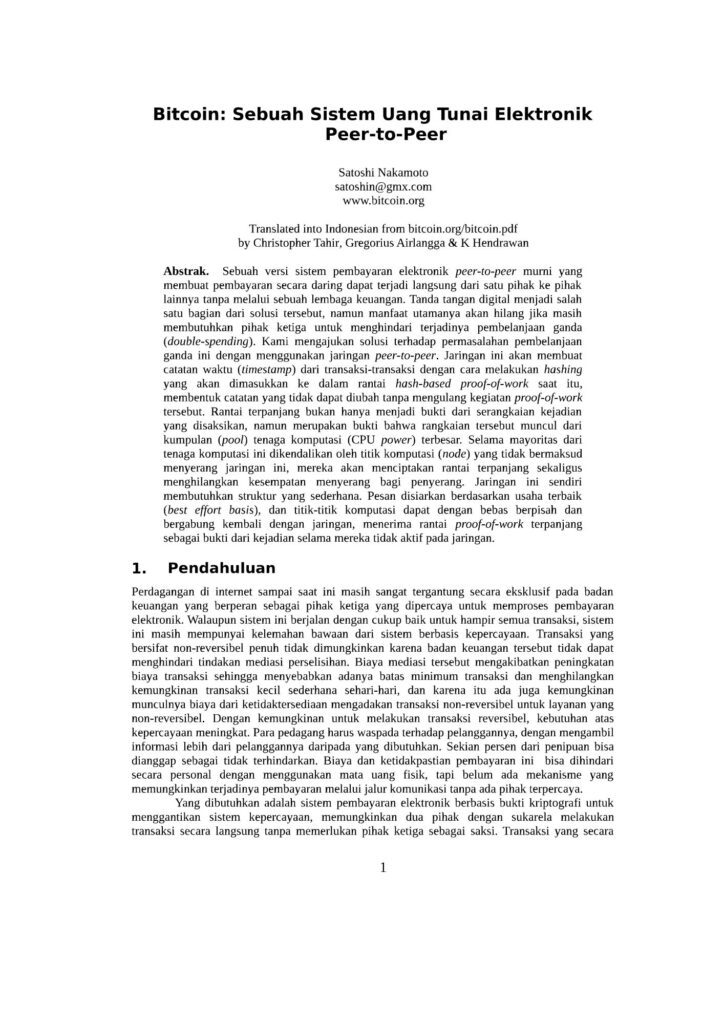The Bitcoin whitepaper, titled “Bitcoin: A Peer-to-Peer Electronic Cash System,” was published on October 31, 2008, by an individual or group of individuals using the pseudonym Satoshi Nakamoto. This document laid the groundwork for the creation of Bitcoin, the first and only truly decentralized cryptocurrency, which introduced the concept of a digital currency that operates without the need for a central authority. This blog post aims to introduce the reader to bitcoin whitepaper and encourage to set some time aside to read it in full. Understanding Bitcoin helps to understand it’s political, social and economic implications for Indonesia.
Read the Bitcoin Whitepaper in Bahasa Indonesia here
Introduction to the Bitcoin Whitepaper
The Bitcoin whitepaper is a concise, nine-page document that outlines the technical framework for a decentralized ledger. Satoshi Nakamoto’s primary objective was to solve the double-spending problem inherent to digital currencies without relying on an institution or a central bank. The paper presents a novel solution using a peer-to-peer network, cryptographic proof, and the timechain to achieve consensus on a ledger of transactions.
Key Components of the Bitcoin Whitepaper
Decentralization: At its core, Bitcoin was designed to be a decentralized system. Unlike traditional currencies, which are controlled by central banks, Bitcoin operates on a network of computers (nodes) that are distributed across the globe. This decentralization ensures that no single entity has control over the network, making Bitcoin resistant to censorship and central points of failure.
Timechain: The whitepaper introduces the concept of a timechain (blockchain), a public ledger that contains all confirmed transactions. This ledger is maintained by nodes in the network through a consensus mechanism. The timechain is immutable, meaning once a transaction is recorded, it cannot be altered, providing transparency and security.
Proof of Work (PoW): Nakamoto proposed the use of a proof-of-work system to add new transactions to the blockchain. This process, known as mining, involves solving complex mathematical puzzles to validate transactions and create new blocks. Miners are rewarded with newly created bitcoins, incentivizing them to secure the network.
Digital Signatures: The whitepaper also highlights the use of digital signatures as a means of ensuring the authenticity of transactions. Each transaction is signed with the sender’s private key and can be verified by anyone using the sender’s public key, ensuring that bitcoins can only be spent by their rightful owners.
Conclusion
The publication of the Bitcoin whitepaper marked the beginning of a new era in cyberspace. Bitcoin’s innovative use of the timechain has inspired the creation of thousands of other shitcoins, each with its unique features and rug-pull capabilities. The Bitcoin whitepaper is not just a technical document; it is a manifesto for financial freedom and innovation. Its publication sparked a revolution in the way we think about money, privacy, and the role of institutions in our financial systems. As we move forward, the principles laid out in the Bitcoin whitepaper continue to influence the development of new technologies and the evolution of digital currencies. Satoshi Nakamoto’s vision of a decentralized, secure, and efficient electronic cash system has undeniably changed the world, challenging us to reimagine the future of governance.






